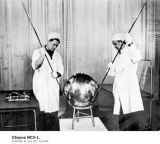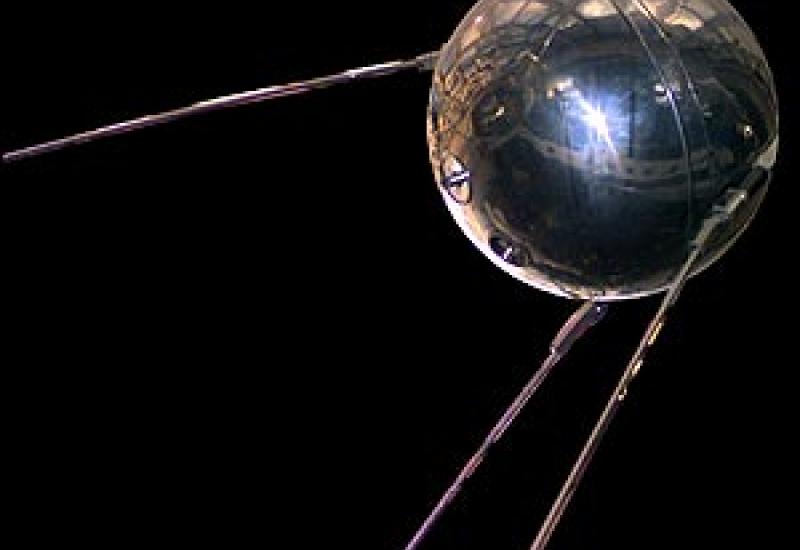1955. Space? Sputnik? These words belonged to science fiction. And although geophysical rocket rose into the sky higher and higher, and even for few minutes reached the comic heights, it was hard to believe that the space age will come so soon.
August 30, 1955 in the office of Vice-President of the USSR there was a meeting.
- A year and a half we will have the carrier, - said S. Korolev. - Do not play for time – it is needed the research program, we need institutions which can give the instruments and apparatus for 5-6 satellites.
The approximate time of the launch was determined - summer 1957.
By that time there were created several single-stage ballistic missiles with a range of 300-1200 km, but to put the satellite into orbit it was needed a fundamentally different missile. In two years, it was necessary to develop and manufacture the equipment, power supplies, temperature control system, telemetry system, the management of the on-board equipment, and more.
According to the decision of the Government of the USSR, it was necessary to put scientific equipment on the sattelite, and its mass must be 1100-1400 kg. But at the end of 1956 it became clear that a scheduled start will not be able to carry out. It was also known that the United States planned to launch their Sputnik in summer.
 Then M.K.Tihonravov 1957 proposed to create a small-size satellite - weighing up to 100 kg. January 5, 1957 Korolev sent a memorandum to the Government on the preparation of the two satellites, one weighing 40-50 kg (it will be the first) and 1200 kg (it will be the third), and offered to prepare the rocket for launch in April - July.
Then M.K.Tihonravov 1957 proposed to create a small-size satellite - weighing up to 100 kg. January 5, 1957 Korolev sent a memorandum to the Government on the preparation of the two satellites, one weighing 40-50 kg (it will be the first) and 1200 kg (it will be the third), and offered to prepare the rocket for launch in April - July.
First rocket capable to launch the artificial satellite into orbit, was tested May 15, 1957 The flight lasted only 90 seconds, but it confirmed the correctness of the design decisions. The second – also failed – was carried out in July. In August 21, 1957 the launch of the R-7 was excellent, the flight program have been fully implemented. This missile opened to the satellite the way to space.
What was the outlook of the first satellite? Handmade "moon" had a spherical shape with a diameter of 58 cm and was weighing 84 kg with four whip antenna length 2.4-2.9 m. In a sealed enclosure satellite filled with nitrogen, it was housed radio equipment and power supplies. Satellite signals were in the form of telegraph sends a length of about 0.3 s, the estimated time of continuous operation was up to 14 days.
The plant workers recalled how difficult it was to provide a shiny surface which reflected sunlight: for aluminum alloy from which the manufactured housing first satellite, at that time there was no special technologies. S.P.Korolev demanded the mirror surface because he was afraid of overheating of satellite by the sunlight.
All were involved in the producing of the "ball", literally carried it on their hands in white gloves. An equipment, where the satellite was mounted, was covered with velvet.
Early in the morning of October 3 rocket docked with the satellite, taken at the start. The work went on schedule, without disruption. The satellite was launched October 4, 1957 in 22 hours 28 minutes Moscow time. Time at Baikonur was as if paused then there were received clear radio signals - "beep beep ... beep ... ..." This was the confirmation of the successful entry into orbit the first artificial Earth satellite.
Observations on the first turn showed that the satellite went into orbit with an inclination of 65.1 degrees, the perigee altitude of 228 km and a maximum distance from the Earth 947 miles. Each of its orbit around the planet lasted a little more than 96 minutes. During its existence, the satellite made within 92 days about 1,400 orbits around the Earth.
In the West, strongly emphasized the technical backwardness of the USSR, including a rocket. After the launch of the Soviet satellite the world was shocked. Here is what was written in the days of the newspaper "The news about the launch of the Russian satellite was a sensation for the civilized world" ("New York Post"); "Soviet Russia has demonstrated one of the greatest achievements of science" ("The Washington Post"), "" We did not expect the Soviet satellite, and so it made an impression on America Eisenhower kind of a new technical Pearl Harbor "(the magazine" Fortune ")," Ninety percent of the conversations an artificial earth satellite had on the United States. But it turned out that one hundred percent of the cases occurred in Russia "(the agency" Associated Press "). By the way, the first satellite of the United States was launched on February 1, 1958 only, and its weight was 14 kg.
Soviet space miracle makers also did not expect that the launch of their creation will have such resonance. A flurry of newspaper reports on the radio to some extent even puzzled them. But if you think about it, there is nothing surprising.
The launch of Sputnik opened the space era in the history of humankind. It clearly demonstrated a high level of scientific and technological development of the USSR and initiated the rapid improvement of space technology. In addition, foreign military experts clearly convinced that the Soviet Union had the multistage intercontinental missile, against which there were powerless the anti-aircraft defense of Western countries.
The second satellite (weighing 508.3 kg) was launched 3 November 1957 and third, weighing 1327 kg - May 15, 1958). This third satellite became the first automatic orbital station. On board there was mounted 12 scientific instruments. It existed in orbit until April 6, 1960 So, the exploration of outer space began.

